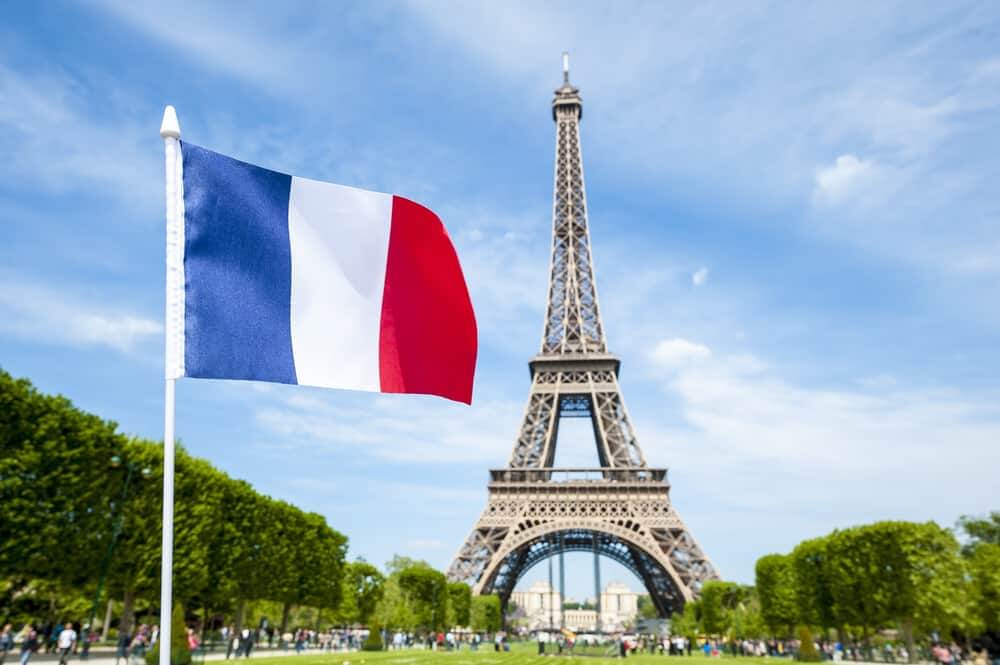What exchange rate does Currensea use?
Find out what exchange rate Currensea uses for card payments, ATM withdrawals and money transfers here in our handy guide.

Interested in the history of the French flag, and how this iconic three-colour design came to be adopted? Read on, as we’ve put together a few of the most interesting facts about the French _tricolore _flag.
This includes what the colours mean, along with some fascinating background on its origins.
And if you’re looking to buy a French flag of your own, for a celebration or to mark your own French heritage, we have some handy tips on where to buy one online.
Plus, how to save money using the Wise card when buying flags from foreign websites in a different currency.
But for now, let’s get back to our interesting facts about the French flag.
Ever wondered what the red, blue and white colours of the French flag stand for? Well, there are a few different meanings and interpretations.
The most commonly known is that the colours represent the three elements of the French revolutionary motto:
Meanwhile, other interpretations claim the colours represent the three principles of the ancien régime, or “old order”. This would make white the symbol for the clergy, red of the nobility and blue of the bourgeoisie.
But there’s also a third explanation. Blue and red are the colours of Paris, the French capital. White is the colour of the king, as well as being an ancient French colour.
You might think there’s a set shade for each of the colours in the French flag, and that these never change. But actually, the blue in the _tricolore _flag has altered over the years.
One of these colour changes even happened recently, when President Emmanuel Macron changed the blue in the flag in July 2020. The colour he chose was a darker shade, which is a return to the navy shade used before 1976. At this time, the colours in the flag were made lighter to better match the flag of the European Union.
Today, there are two official forms of the French flag in use - the lighter and the darker shades.
The French flag we see today hasn’t always been the country’s official flag. In fact, it used to look very different indeed.
The _tricolore _design replaced a previous flag, known as the fleur-de-lis. This was the national emblem of France, displayed on the flag in gold against a rich blue background.
Everything changed with the French Revolution, taking place between 1787 and 1799. The blue and red colours were worn on the uniforms of the revolutionaries, and this formed the basis for a new national flag.
With the addition of a white stripe by French general Gilbert du Motier, Marquis de Lafayette, the new _tricolore _design was born. The Drapeau Tricolore was officially accepted by the Constituent Assembly on 24th October, 1790.
Just like a previous French flag was adorned by the fleur-de-lis, the current design also takes its inspiration from a French national ornament.
In this case, it’s the cockade of France, or the Cocarde tricolore. A cockade is very similar to a rosette, which was often attached to hats and other parts of uniforms. This formed a key component of the uniforms of revolutionaries during the French Revolution.
The French cockade was originally blue and red, the colours of Paris. The white was added by the Marquis of Lafayette, to symbolise loyalty to the Sovereign.
The cockade became the symbol of the revolution, and later became the French flag as we know it today.
In the early 17th century, the royal standard of France was plain, pure white. It had no other adornment, other than occasionally featuring the fleur-de-lis when in the presence of the king.
The flag was used as a symbol of purity, as well as of military command. It made a brief resurgence during the Bourbon Restoration, when the _tricolore _was seen as a symbol of regicide. But the attempt to retain the white flag was abandoned in 1830, and the _tricolore _has remained the national flag ever since.
If you’d like your very own French flag, it’s easy to find and buy one online.
You can find French flags for sale at popular e-commerce sites like Amazon or eBay.
Alternatively, you can use a specialist flag seller such as theflagshop.co.uk, flagmakers.co.uk or www.flyingcolours.org.
If you’ll be buying your French flag from a French or other overseas seller, you’ll need to watch out for high currency conversion costs. Pay with a Wise card and you can pay in a choice of 50 currencies at the mid-market exchange rate.
There’s just a small conversion fee to pay, or it’s free if you already have the currency in your Wise account. It’s the smarter, cheaper way to shop internationally online, whether you’re buying a French flag or anything else.
Please see the Terms of Use for your region or visit Wise fees & pricing for the most up-to-date information on pricing and fees.
With its origins in the French revolution, the _tricolore _has become one of the world’s most famous flags. But it only became France’s national symbol after a long and turbulent history.
Hopefully after reading this, you have a little more insight into the history and symbolism of the French flag. This includes some fascinating facts, which you can use to impress friends and family with your newfound knowledge.
And if you want to buy one of your own, you’ll now know where to look online - and how to save money when purchasing from foreign websites by using the Wise card.
Sources used:
Sources last checked on date: 16-Apr-2023
*Please see terms of use and product availability for your region or visit Wise fees and pricing for the most up to date pricing and fee information.
This publication is provided for general information purposes and does not constitute legal, tax or other professional advice from Wise Payments Limited or its subsidiaries and its affiliates, and it is not intended as a substitute for obtaining advice from a financial advisor or any other professional.
We make no representations, warranties or guarantees, whether expressed or implied, that the content in the publication is accurate, complete or up to date.

Find out what exchange rate Currensea uses for card payments, ATM withdrawals and money transfers here in our handy guide.

Compare Currensea vs. Wise in our comprehensive UK guide, covering fees, features, travel cards, exchange rates and more.

Read our comprehensive Currensea review, focusing on fees, exchange rates and transfer times for international money transfers.

Read our FairFX currency card review, covering exchange rates, limits, fees and more.

Find out how to cancel your Revolut card as a UK customer here in our handy guide, including how to close your account.

What are marketplace scams and how can you avoid them? Learn how you can protect yourself and how to report suspected scams to Wise.